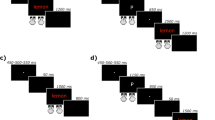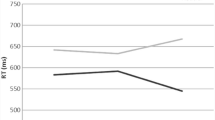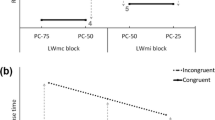Abstract
Performance on the Stroop task reflects two types of conflict—informational (between the incongruent word and font color) and task (between the contextually relevant color-naming task and the irrelevant, but automatic, word-reading task). According to the dual mechanisms of control theory (DMC; Braver, 2012), variability in Stroop performance can result from variability in the deployment of a proactive task-demand control mechanism. Previous research has shown that when proactive control (PC) is diminished, both increased Stroop interference and a reversed Stroop facilitation (RF) are observed. Although the current DMC model accounts for the former effect, it does not predict the observed RF, which is considered to be behavioral evidence for task conflict in the Stroop task. Here we expanded the DMC model to account for Stroop RF. Assuming that a concurrent working memory (WM) task reduces PC, we predicted both increased interference and an RF. Nineteen participants performed a standard Stroop task combined with a concurrent n-back task, which was aimed at reducing available WM resources, and thus overloading PC. Although the results indicated common Stroop interference and facilitation in the low-load condition (zero-back), in the high-load condition (two-back), both increased Stroop interference and RF were observed, consistent with the model’s prediction. These findings indicate that PC is modulated by concurrent WM load and serves as a common control mechanism for both informational and task Stroop conflicts.


Similar content being viewed by others
Notes
Following Botvinick et al. (2001), we computed task conflict as the multiplication of the activation (in the 0–1 interval) of the task units.
References
Aarts, E., Roelofs, A., & van Turennout, M. (2009). Attentional control of task and response in lateral and medial frontal cortex: Brain activity and reaction time distributions. Neuropsychologia, 47, 2089–2099. doi:10.1016/j.neuropsychologia.2009.03.019
Bench, C. J., Frith, C. D., Grasby, P. M., Friston, K. J., Paulesu, E., Frackowiak, R. S., & Dolan, R. J. (1993). Investigations of the functional anatomy of attention using the Stroop test. Neuropsychologia, 32, 907–922.
Botvinick, M. M., Braver, T. S., Barch, D. M., Carter, C. S., & Cohen, J. D. (2001). Conflict monitoring and cognitive control. Psychological Review, 108, 624–652. doi:10.1037/0033-295X.108.3.624
Botvinick, M. M., Nystrom, L. E., Fissell, K., Carter, C. S., & Cohen, J. D. (1999). Conflict monitoring versus selection-for-action in anterior cingulate cortex. Nature, 402, 179–181. doi:10.1038/46035
Braver, T. S. (2012). The variable nature of cognitive control: A dual mechanisms framework. Trends in Cognitive Sciences, 16, 106–113. doi:10.1016/j.tics.2011.12.010
Bugg, J. M., McDaniel, M. A., Scullin, M. K., & Braver, T. S. (2011). Revealing list-level control in the Stroop task by uncovering its benefits and a cost. Journal of Experimental Psychology: Human Perception and Performance, 37, 1595–1606.
Carter, C. S., Braver, T. S., Barch, D. M., Botvinick, M. M., Noll, D., & Cohen, J. D. (1998). Anterior cingulate cortex, error detection, and the online monitoring of performance. Science, 280, 747–749. doi:10.1126/science.280.5364.747
Carter, C. S., Mintun, M., & Cohen, J. D. (1995). Interference and facilitation effects during selective attention: An H2 15O PET study of Stroop task performance. NeuroImage, 2, 264–272. doi:10.1006/nimg.1995.1034
Cohen, J. D., Dunbar, K., & McClelland, J. L. (1990). On the control of automatic processes: A parallel distributed processing account of the Stroop effect. Psychological Review, 97, 332–361. doi:10.1037/0033-295X.97.3.332
Cohen, J. D., & Servan-Schreiber, D. (1992). Context, cortex and dopamine: A connectionist approach to behavior and biology in schizophrenia. Psychological Review, 99, 45–77. doi:10.1037/0033-295X.99.1.45
Cousineau, D. (2005). Confidence intervals in within-subjects designs: A simpler solution to Loftus and Masson’s method. Tutorial in Quantitative Methods for Psychology, 1, 42–45.
David, I. A., Volchan, E., Vila, J., Keil, A., de Oliveira, L., Faria-Júnior, A. J. P., & Machado-Pinheiro, W. (2011). Stroop matching task: Role of feature selection and temporal modulation. Experimental Brain Research, 208, 595–605. doi:10.1007/s00221-010-2507-9
de Fockert, J. W., Rees, G., Frith, C. D., & Lavie, N. (2001). The role of working memory in visual selective attention. Science, 291, 1803–1806. doi:10.1126/science.1056496
De Pisapia, N., & Braver, T. S. (2006). A model of dual control mechanisms through anterior cingulate and prefrontal cortex interactions. Neurocomputing, 69, 1322–1326.
Gibson, J. J. (1979). The ecological approach to visual perception. Boston: Houghton Mifflin.
Goldfarb, L., & Henik, A. (2007). Evidence for task conflict in the Stroop effect. Journal of Experimental Psychology: Human Perception and Performance, 33, 1170–1176. doi:10.1037/0096-1523.33.5.1170
Gratton, G., Coles, M. G. H., & Donchin, E. (1992). Optimizing the use of information: Strategic control of activation of responses. Journal of Experimental Psychology: General, 121, 480–506. doi:10.1037/0096-3445.121.4.480
Kalanthroff, E., Anholt, G. E., & Henik, A. (2014). Always on guard: Test of high vs. low control conditions in obsessive-compulsive disorder patients. Psychiatry Research, 219, 322–328. doi:10.1016/j.psychres.2014.05.050
Kalanthroff, E., Goldfarb, L., Usher, M., & Henik, A. (2013a). Stop interfering: Stroop task conflict independence from informational conflict and interference. Quarterly Journal of Experimental Psychology, 66, 1356–1367. doi:10.1080/17470218.2012.741606
Kalanthroff, E., Goldfarb, L., & Henik, A. (2013b). Evidence for interaction between the stop signal and the Stroop task conflict. Journal of Experimental Psychology: Human Perception and Performance, 39, 579–592. doi:10.1037/a0027429
Kalanthroff, E., & Henik, A. (2013). Individual but not fragile: Individual differences in task control predict Stroop facilitation. Consciousness and Cognition, 22, 413–419. doi:10.1016/j.concog.2013.01.010
Kalanthroff, E., & Henik, A. (2014). Preparation time modulates pro-active control and enhances task conflict in task switching. Psychological Research, 78, 276–288. doi:10.1007/s00426-013-0495-7
Kane, M. J., & Engle, R. W. (2003). Working-memory capacity and the control of attention: The contributions of goal neglect, response competition, and task set to Stroop interference. Journal of Experimental Psychology: General, 132, 47–70. doi:10.1037/0096-3445.132.1.47
La Heij, W., Boelens, H., & Kuipers, J. R. (2010). Object interference in children’s colour and position naming: Lexical interference or task-set competition? Language &Cognitive Processes, 25, 568–588.
MacLeod, C. M. (1991). Half a century of research on the Stroop effect: An integrative review. Psychological Bulletin, 109, 163–203. doi:10.1037/0033-2909.109.2.163
MacLeod, C. M., & MacDonald, P. A. (2000). Interdimensional interference in the Stroop effect: Uncovering the cognitive and neural anatomy of attention. Trends in Cognitive Sciences, 10, 383–391. doi:10.1016/S1364-6613(00)01530-8
Makris, S., Hadar, A. A., & Yarrow, K. (2011). Viewing objects and planning actions: On the potentiation of grasping behaviors by visual objects. Brain and Cognition, 77, 257–264.
Meier, M. E., & Kane, M. J. (2012). Working memory capacity and Stroop interference: Global versus local indices of executive control. Journal of Experimental Psychology: Learning, Memory, and Cognition, 39, 748–759.
Miller, E. K., & Cohen, J. D. (2001). An integrative theory of prefrontal cortex function. Annual Review of Neuroscience, 24, 167–202. doi:10.1146/annurev.neuro.24.1.167
Miyake, A., Friedman, N. P., Emerson, M. J., Witzki, A. H., Howerter, A., & Wager, T. D. (2000). The unity and diversity of executive functions and their contributions to complex “frontal lobe” tasks: A latent variable analysis. Cognitive Psychology, 41, 49–100. doi:10.1006/cogp.1999.0734
Owen, A. M., McMillan, K. M., Laird, A. R., & Bullmore, E. (2005). N-back working memory paradigm: A meta-analysis of normative functional neuroimaging studies. Human Brain Mapping, 25, 46–59. doi:10.1002/hbm.20131
Rogers, R. D., & Monsell, S. (1995). Costs of a predictable switch between simple cognitive tasks. Journal of Experimental Psychology: General, 124, 207–231. doi:10.1037/0096-3445.124.2.207
Soutschek, A., Strobach, T., & Schubert, T. (2013). Working memory demands modulate cognitive control in the Stroop paradigm. Psychological Research, 77, 333–347. doi:10.1007/s00426-012-0429-9
Steinhauser, M., & Hübner, R. (2009). Distinguishing response conflict and task conflict in the Stroop task: Evidence from ex-Gaussian distribution analysis. Journal of Experimental Psychology: Human Perception and Performance, 35, 1398–1412.
Stroop, J. R. (1935). Studies of interference in serial verbal reactions. Journal of Experimental Psychology, 18, 643–662. doi:10.1037/0096-3445.121.1.15
Turner, M. L., & Engle, R. W. (1989). Is working memory capacity task dependent? Journal of Memory and Language, 28, 127–154. doi:10.1016/0749-596X(89)90040-5
Tzelgov, J., Henik, A., & Berger, J. (1992). Controlling Stroop effects by manipulating expectations for color words. Memory & Cognition, 20, 727–735. doi:10.3758/BF03202722
Zhao, Y., Tang, D., Hu, L., Zhang, L., Hitchman, G., Wang, L., & Chen, A. (2014). Concurrent working memory task decreases the Stroop interference effect as indexed by the decreased theta oscillations. Neuroscience, 262, 92–106. doi:10.1016/j.neuroscience.2013.12.052
Author note
The first two authors contributed equally to this research. We thank Desiree Meloul for critical reading of the manuscript, and Alexander Soutschek for allowing us access to his data. M.U. is supported by the Israeli Science Foundation (Grant No. 743/12) and the German–Israel Foundation (Grant No. 158/2011) and by a Visiting Professorship at the University of Oxford from the Leverhulme Trust.
Author information
Authors and Affiliations
Corresponding author
Electronic supplementary material
Below is the link to the electronic supplementary material.
ESM 1
(PDF 92 kb)
Rights and permissions
About this article
Cite this article
Kalanthroff, E., Avnit, A., Henik, A. et al. Stroop proactive control and task conflict are modulated by concurrent working memory load. Psychon Bull Rev 22, 869–875 (2015). https://doi.org/10.3758/s13423-014-0735-x
Published:
Issue Date:
DOI: https://doi.org/10.3758/s13423-014-0735-x




